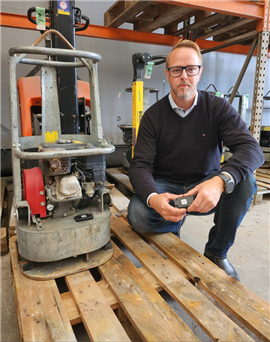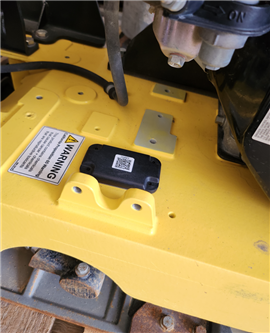How a device the size of a credit card might help lower your company’s CO2 emissions
23 October 2023
Andreas Eriksson, CEO at Taggr AB, says new insight into actual machine usage could bring unprecedented benefits to equipment owners looking to reduce their carbon footprint and operational costs
 Andreas Eriksson, CEO of Taggr AB, holds the device that can track actual machine usage on even the smallest items in a rental inventory
Andreas Eriksson, CEO of Taggr AB, holds the device that can track actual machine usage on even the smallest items in a rental inventory
Stockholm-based telematics specialist Taggr has partnered with Loxam-owned Ramirent to help the company track usage, location and carbon emissions on thousands of its machines - not the large, capital pieces of equipment typically logging data, but the smaller tools and items normally ignored by most systems.
Why should these smaller machines be tagged and tracked? Andreas Eriksson, CEO of Taggr AB, says there’s a lot to be gained in operational efficiencies through the technology he claims is simple and low cost.
We spoke with Eriksson about the Taggr technology, what it does and how it might manage to lower a company’s carbon emissions.
Rental Briefing: Tell us about Taggr and what it offers that’s different from other telematics systems.
Eriksson: Taggr turns passive objects into information-generating intelligent assets. It could be something as simple and low-cost as a lawnmower, a plate compactor, or a drill. Rental companies don’t usually view objects like these as “assets,” they’re just objects in their inventory, or maybe in the best case just an asset, but definitively not intelligent. We can turn them into valuable, intelligent assets, offering valuable insight into actual machine usage with the goal of reducing unnecessary costs, and thereby lowering the owner’s carbon footprint.
Ramirent in Sweden has been part of this effort almost since the beginning. We determined pretty early that we would not compete on heavy equipment, because the OEMs are already doing that. We want to be involved with light and compact equipment. Instead of addressing a few thousand pieces of heavy equipment for a company, we can track millions of units.
Rental Briefing: What does that do for the fleet owner?
Eriksson: There are four things it does. First, we can improve operational efficiency by showing actual machine usage. Often, machines are rented for a few days, but only used a small portion of that time. Tapping into this information opens up the door for a huge optimization of fleet size and operational efficiency. The cost of investment with Taggr brings approximately two times the return on investment on just this point alone.
Another one is out-of-office-hours usage of equipment. Normally, when you rent equipment, you’re only renting it Monday to Friday, 7 a.m. to 4 p.m. or 8 a.m. to 5 p.m. There’s a huge revenue leakage because in reality, renters are using the item on weekends, during the evening, on bank holidays, etc.
The third case is lower service and maintenance on the equipment. Most companies are over-servicing machines. Because there has been no way of accurately knowing how much usage occurred during the rental, often machines are automatically given full service based on statistical intervals, even when it’s not technically necessary based on actual usage. In other words, if a machine has been rented out for 10 days and the service threshold is 10 days, the rental company will service the machine. But if you look at how the machine was actually used, it might only need one service per year.
Likewise, damage control of equipment is another case. Customers sometimes drop or mishandle equipment, but never mention it, causing unplanned downtime further down the line.
Finally, extending the lifetime of equipment is hugely impactful on the environmental side. That’s connected to the machine not being used as much as is thought. Rental companies might have a policy of keeping machines for seven years, but based on actual usage, it might have been used only two and half years during that timeframe. In this way, its lifetime can be extended up to perhaps 10 years, not only lowering costs for the equipment owner, but lessening their carbon footprint as well.
By allowing visibility into the actual use of equipment, rental companies are able to reduce a lot of processes that are done automatically. You can optimize maintenance and repair based on real and actual machine usage.
Rental Briefing: How else does Taggr help companies lower their emissions?
Eriksson: One of the major drivers behind emissions reduction is the EU-driven Corporate Sustainability Reporting Directive (CSRD). It affects almost all rental companies, which now need to report their emissions. It’s very difficult to make a business case out of that because it’s just an expense, it’s a cost. That was one of our drivers as well - let’s put the cost of our service down so low that companies can be compliant with CSRD without a pressing need to earn their money back on a major operational transformation of their business.
That’s what’s hindering a lot of the IoT and digital transformation efforts. The equipment and technology is here, but you need to transform the way a company works, you have to change
 The Taggr device turns even small tools and machines into intelligent assets, helping rental companies streamline service and maintenance for a reduction in their carbon emissions
The Taggr device turns even small tools and machines into intelligent assets, helping rental companies streamline service and maintenance for a reduction in their carbon emissions
processes, manuals, etc.
Rental companies are currently over reporting emissions because they generalize how the machines are being used, and the machines are not being used as much as they think. If you look back at service intervals as a benchmark, many machines have been overserviced. You’re changing the oil more than you need to, buying and using more stuff to service the machines, throwing away more stuff than is necessary. You’re damaging the environment because you’re replacing stuff that really didn’t need to be replaced.
So with that in mind, companies over report their CO2 emissions. A machine that has been rented out for eight hours in one day gets, in the worst case, calculated as eight hours of run time for the engine. If someone has rented a machine for four weeks, what we see is it’s often used only 5% to 10% of that time, so there could be a huge reduction in the reporting of emissions. Part of that doesn’t have a direct impact on the environment because the machines are not consuming more fuel or less, it’s just the reporting discrepancy. So first, we’re trying to correct that.
Some things that can lead to a 30% to 50% actual reduction of emissions include shorter transportation routes due to better, more-informed logistics. Another is extending the lifetime of equipment, and a third is reducing unnecessary service. Taggr addresses all of those issues.
For a company like Ramirent and the Loxam Group in Europe, just correcting reporting has a huge impact on them, especially since Ramirent, for example, is aiming to have a completely carbon neutral offer in the future.
Rental Briefing: What is the cost outlay for rental companies for Taggr?
Eriksson: We run a pure service model. There’s no capex investment for our customers, they actually don’t buy the tag. They sign up to an information subscription, and if we don’t deliver information to them, they don’t pay.
Rental Briefing: Where do you see technology like yours going from here?
Eriksson: Right now we’re addressing the rental companies and we have good interest. We’re testing and have pilots with several Swedish companies and we’re on our way out to Europe as well. We’re expanding in the construction industry, as well as to the transportation and logistics sector.
STAY CONNECTED



Receive the information you need when you need it through our world-leading magazines, newsletters and daily briefings.
CONNECT WITH THE TEAM








